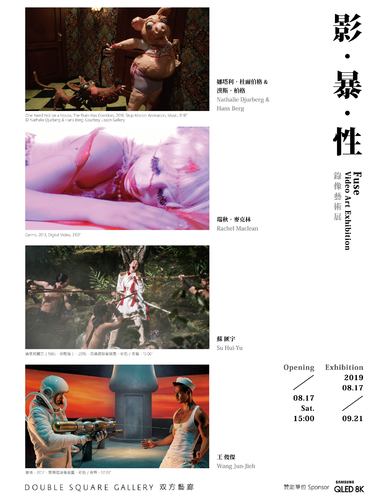Fuse-Video Art Exhibition
8/17 (Sat) - 9/21/2019 (Sat)
Nathalie Djurberg & Hans Berg (Sweden), Rachel Maclean (UK), Su Hui-Yu (Taiwan), Wang Jun-Jieh (Taiwan)

Double Square Gallery is proud to present Fuse—Video Art Exhibition from August 17 to September 21, 2019. The exhibition showcases three artists and one artist duo from Taiwan and abroad, including Nathalie Djurberg and Hans Berg (Sweden), Rachel Maclean (UK), WANG Jun-Jieh (Taiwan) and SU Hui-Yu (Taiwan), with art critic SHEN Bo-Cheng as the exhibition’s academic researcher. The exhibition title “fuse” conveys the concept of using image and sound signals to form stimulations and release unknown dormant potentiality or spiritual dimension within us.
As Shen stated, “This exhibition resembles a detonator comprising of flesh and blood, fluid and hormones that aims to provoke the audience’s reflection on ‘animal corporeality’; and the signals that constitute the images of senses and fantasies are precisely the electric stimulations emitted from the artists and the exhibition.”
The works on view in the exhibition employ the combination of image and sound to explore contemporary social issues about identity, gender awareness, political power, popular culture, social violence and consumerism, leading the audience to examine their surrounding world from diverse perspectives. Three artists featured in the exhibition have been invited to participate in the Venice Biennale: the work of Nathalie Djurberg and Hans Berg was showcased in the main exhibition of the Biennale and awarded the Silver Lion; Rachel Maclean was showcased in the Scotland Pavilion and WANG Jun-Jieh the Taiwan Pavilion. Su Hui-Yu is the recipient of the Taishin Visual Arts Award in this year’s Taishin Arts Award presented in May. The featured artists have received critical accolades from around the world. The works by Nathalie Djurberg and Hans Berg were praised by The Guardian as “the world's weirdest claymations” and have been included in the collections of MoMA, New York and the Prada Foundation in Milan. Rachel Maclean is a highly anticipated and emerging artist in the UK. She has held a solo exhibition at Tate Britain and is a commissioned artist for the BBC. In recent years, SU Hui-Yu has been invited by multiple international film festivals for special screenings, such as the International Rotterdam Film Festival. WANG Jun-Jieh started creating video art in 1984 and has been viewed as one of the pioneers in Taiwan’s new media art scene. He is also a curator and has participated in various major international biennials, including Gwangju Biennale and Venice Biennale. For the debut of Su Hui-Yu’s award-winning video installation in Taipei, Double Square Gallery also forms a special partnership with SamsungTaiwan to present the work with four 82-inch flat TVs, bringing the audience a unique visual experience with superb colors and definition.
Fuse—Video Art Exhibition features the video works of the aforementioned artists and primarily explores contemporary social issues and human instinctual desires.
Artist Nathalie Djurberg and Hans Berg, an electronic music artist, employ object, sound and image to create a fantastic yet realistic animated world. In One Need Not be a House The Brain Has Corridors, viewers follow the camera lens and wander through endless corridors. The combination of mysterious, eerie music and clay dolls wandering in a labyrinth forms a realm of fantasy that is filled with surprises yet permits not escape. Interweaving sound and image, the artist duo transforms “video” into a journey of inner exploration, during which human desires – ranging from violence, sexual seduction, fetishism, materialism, etc. – are turned into clay dolls performing in front of viewers’ eyes.
Rachel Maclean specializes in combining green screen technology, exaggerating computer effects, feminine costume and make-up as well as splendid colors to create a surreal world that discusses desires and fears lurking in modern-day consumerist systems. In the three-minute long video, Germs, the artist plays multiple roles to sharply analyzes and portrays consumers’ anxieties in facing odors, stains, germs and viruses in daily life. A parody of TV commercials, the video visualizes modern people’s inevitable fate of being devoured by blind consumption and paranoia. With a hint of humor, the artist employs various characters and changing identities to point out the worries and panic induced by the consumerism of our time.
※ Exhibition works contain explicit content, viewers discretion advised.
SU Hui-Yu is the latest recipient of the 17th Taishin Visual Arts Award. His award-winning work The Glamorous Boy of Tang (1985, Chiu Kang-Chien) is a video work created with the approach of “re-shooting.” Drawing inspiration from the well-known poet and playwright CHIU Kang-Chien’s first feature film, The Glamorous Boy of Tang, Su extracts the essence of fantasy from the original work; and instead of re-making the film, he re-interprets the cinematic text and continues developing it. Integrating new resource, video techniques as well as a wide spectrum of bodies and subcultural communities in the diverse contemporary society, he re-shoots the radical and passionate scenes removed from the original work due to censorship or market concerns, injecting new ideas that expand and further the potential of the original film.
Passion by WANG Jun-Jieh starts with the appearance of an astronaut named “Hal” on a lust-filled wharf with penis-shaped bollards, ensued by a physical fight and struggle of three sailors that eventually end in death with heated passion evaporating into thin air. As the title suggests, “passion” not only stems from the physical desire, it is also the driving force and energy of life. With influences from Querelle (1982) by German director Rainer Werner Fassbinder (1945-1982), Passion (1982) by French director Jean-Luc Godard (1930-) and 2001: A Space Odyssey (1968) by American director Stanley Kubrick (1928-1999), the artist fuses “desire” into “video” through re-interpretation and re-reading, showing creative passion as lustful desires that propel the human life.